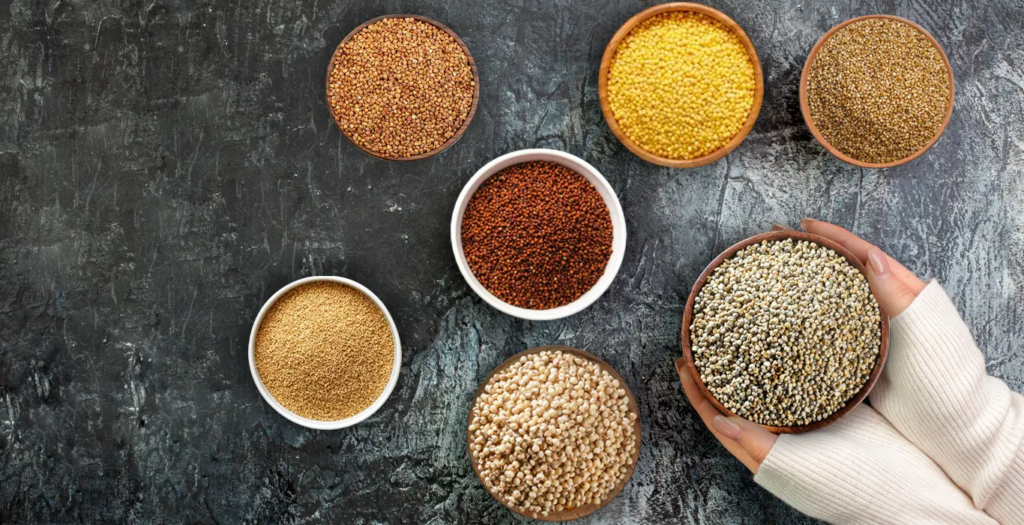
The United Nations has declared 2023 as the International Year of Millet (IYOM) in response to a resolution in the 75th Session of the U.N. General Assembly sponsored by India and supported by more than 72 countries. This is a proud moment for Indian farmers as India is the largest producer of millet in the world –and accounts for 20% of global production and 80% of Asian production.
Millets are among the first plants to be grown by humans and are called super-food or nutri-cereals because of their high nutritional content. Millets are grown in 131 countries. They are a part of the traditional food for 59 crore people (more than half a billion) in Asia & Africa and are known to possess a number of health benefits.
Millets are a gift of nature to mankind. According to the Food Safety and Standards Authority of India (FSSAI) millets contain 7-12% protein, 2-5% fat, 65-75% carbohydrates and 15-20% dietary fibre. Due to their high density of nutrients including vitamins, minerals, phytochemicals and dietary fibre, millets are also excellent grains to alleviate malnutrition and micronutrient deficiency.
They are an alternative vegetarian food as well as a storehouse of micronutrients, vitamins and minerals. Millets provide a balanced diet and can grow on relatively poor soils –under adverse and arid conditions, with comparatively fewer inputs than other cereals.
This notwithstanding, the cultivation of millets is declining in many countries and their potential to address food and nutritional security is not being realized. Hence, there is an urgent need to promote the nutritional and ecological benefit of millets to consumers, producers, and decision-makers; to improve production efficiency, research and development investments and intra-food sector linkages.
The idea behind the International Year of Millets is to increase global production, ensure efficient processing and consumption, promote a better utilization of crop rotations, and encourage better connectivity throughout food systems to promote millets as a key component of the food basket. The International Year will (i) elevate awareness of the contribution of millets for food security and nutrition (ii) inspire stakeholders on improving sustainable production and quality of millets; and (iii) draw focus for enhanced investment in research and development and extension services to achieve the other two aims.
According to the Food and Agriculture Organisation (FAO), the aim is to increase awareness about millet in food security and nutrition and to encourage investments in research and development for the same.
Prime Minister Narendra Modi had also highlighted the benefits of Millets in one of the editions of his monthly radio programme ‘Mann ki Baat’ in which he said that the crop does not require much water and gets ready in a short time.
India plans to organize millet promotional activities in South Africa, Dubai, Japan, South Korea, Indonesia, Saudi Arabia, Sydney, Belgium, Germany, the United Kingdom and the United States of America in the form of food shows, buyer-seller meets and road shows.
Asia and Africa are the major production and consumption areas for millet crops. India, Niger, Sudan and Nigeria are the major producers of millet.
Different varieties of millets include: Sorghum (Jowar), Pearl Millet (Bajra), Finger Millet (Ragi/Mandua), Minor Millets i.e. Foxtail Millet (Kangani/Kakun), Proso Millet (Cheena), Kodo Millet (Kodo), Barnyard Millet (Sawa/Sanwa/ Jhangora), Little Millet (Kutki) and two Pseudo Millets (Buckwheat (Kuttu) and Amaranthus (Chaulai).
Jowar and Proso Millets (Common Millet) are the most cultivated millets in 112 and 35 countries respectively. Sorghum and pearl millets cover more than 90% area and production. Remaining production comes from Ragi (Finger Millets), Cheena (Proso Millets), Foxtail Millets (Kangni) and other non-segregated millets.
India produces more than 170 lakh tons (80% of Asia’s & 20% of global production). Most of the states in India grow one or more millet crop species. During the last 5 years, India produced between 13.71 to 18 million tonnes annually with the highest production occurring in 2020-21. According to an estimate the millets market in India is set to grow from its current market value of USD 9 billion to over USD 12 billion by 2025.
Rajasthan, Maharashtra, Karnataka, Gujarat and Madhya Pradesh are India’s top five millet producing states. Share of export of millets is only 1% of the total millet production. Exports of millets from India include mainly whole grain while the export of value-added products of millets from India is negligible.
The Indian Ministry of Agriculture & Farmers Welfare has taken several initiatives to promote domestic and international production and supply of millets. A series of pre-launch programs are being organized to bring about awareness of and public interest in this extremely nutritious grain.
According to the Union Agriculture and Farmers Welfare Minister Narendra Singh Tomar the International Year of Millets (IYOM) – 2023 will provide an opportunity to increase global production, efficient processing and better use of crop rotation and it will promote millets as a major component of the global food basket.
According to him, the Ministry of Agriculture and Farmers Welfare is working in mission mode to increase millet production and consumption in collaboration with all State Governments and other stakeholder organizations.
“The time has come for the Public Distribution System to shift the focus of distribution programs from basic calories to provide a more diverse food basket that includes millets to improve the nutritional status of pre-school children and women of reproductive age,” he said.
Significantly the Government of India had notified millet as a nutritious cereal in April-2018 and, in consideration of the nutritional value of millets, also included it in the Poshan Mission campaign.
Today Millets are an important component of the National Food Security Mission (NFMS) being implemented in 212 districts of 14 States. The Union Ministry of Agriculture is promoting sustainable production, developing markets and research for higher consumption of millets. More than 100 odd startups have been provided funding for recipes and value-added products to promote consumption of millet. Currently there are more than 500 startups working in the millet value-added chain in India. This is besides 250 startups being nurtured by the Indian Institute of Millets under the Rashtriya Krishi Vikas Yojana – Remunerative Approaches for Agriculture and Allied Sectors Rejuvenation (RKVY-RAFTAAR) — a flagship scheme of Government of India, Ministry of Agriculture and Farmers’ Welfare (MoA&FW).
As a part of its efforts, the Department of Food and Public Distribution (DFPD) has ordered all its offices to introduce and promote millets in their canteens and in meetings. Apart from this, a number of initiatives being taken up by respective state governments for the welfare of farmers.
“Our aim is to increase the domestic and global consumption of Millets,” the Union Agriculture and Farmers Welfare Minister said at a function attended by over 100 High Commissioners/Ambassadors from different embassies based in Delhi.
Addressing a gathering, Minister of External Affairs, Dr S. Jaishankar pointed out that Millets are important for food security as well as international relations and food security, particularly on the backdrop of COVID, climate change, and conflicts.
According to Dr. Jaishankar, COVID was a period that reminded the world what a pandemic could do to food security. He said that climate changes can lower production and disrupt trade, hence there is a pressing need in the field of international relations to pay much greater attention to food security, he suggested.





Add comment